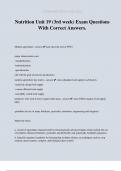©THEBRIGHTSTARS 2024
Nutrition Unit 19 (3rd week) Exam Questions
With Correct Answers.
Modern agriculture - answer✔used since the end of WW2
major characteristics are:
-standardization
-industralization
-specialization
(all with the goal of increase production)
modern agriculture has lead to - answer✔-most abundant food supply in all history
-realitvely cheap food supply
-a more efficient food supply
-incredibly varied food supply
producers who wish to have organic label must - answer✔-meet USDA organic food supply
label
-prohibits the use of many fertilizers, pesticides, hormones, engineering and irrigation
-
Match the items.
a. system of agriculture characterized by technologically advanced inputs which include the use
of synthetic chemical fertilizers, pesticides and herbicides and genetically modified organisms.
b. federally regulated standards for farming that includes reliance on techniques such as crop
rotation, green manure, compost, and biological pest control.
, ©THEBRIGHTSTARS 2024
c. system of agriculture that emphasizes the production of food, fiber, or other plant or animal
products using farming techniques that protect the environment, public health, human
communities, and animal welfare.
1. sustainable agriculture
2. organic agriculture
3. conventional (modern) agriculture - answer✔1. sustainable agriculture C
2. organic agricultureB
3. conventional (modern) agricultureA
Conventional (modern, industrial) agriculture system of agriculture characterized by -
answer✔technologically advanced inputs which include the use of synthetic chemical
fertilizers, pesticides and herbicides and genetically modified organisms.
Organic agriculture involves - answer✔federally regulated standards for farming that includes
reliance on techniques such as crop rotation, green manure, compost, and biological pest control.
Sustainable agriculture is a system of agriculture that - answer✔emphasizes the production of
food, fiber, or other plant or animal products using farming techniques that protect the
environment, public health, human communities, and animal welfare.
agriculte - answer✔the practice of growing crops and raising animals for food and other items
how old is agriculture - answer✔agriculte is 5000 years old (widely established)
10,000 years old for spastically practiced
only 3% of the earth history
before 11,000 BC
, ©THEBRIGHTSTARS 2024
around 11,000 BC people started to - answer✔(homo sapiens (first modern humans) 150,000
years old. (hunting and gathering) (during this time few suffered from diet illnesses and lived
well into 70s)
people stared to move away from hunter gathers.
by 6000 BC
by 5000 BC - answer✔most of the farm animals had been domesticated like the ones that we
see today
agricuture was prated in every major content expect Australia
what encouraged the change from hunting/gathering to farming - answer✔-climate change=
less animals to hunt
-populations growing too big
-food processing technology
-innovation of food harvesting
-farming yield 10 to 100x more calories/acre
though out history societies food systems have swayed between - answer✔hardships and
prosperity
increase global good production fought against: population growth, resource degradtion,
changing climates, droughts, flooding, diseases, war, etc
early farmers often worked the land to degrade the soil - answer✔irrigation (6000bc) helped
and plow (3000BC) helped increase production however worsened the soil through erosion
, ©THEBRIGHTSTARS 2024
rome had depleted its soil before common err. they had to get their wheat shipped 1000 miles
away. this lead roman emporor more vonurable to political, environment and economically.
parts of Europe would fall into famine
17th century Europe falling into famine was helped by
by 1650 to 1850 the population - answer✔manure, crop rotation, cover crops,
almost doubles. = Americans important a lot of important food crops to Europe refrigerated
transport helped, improved processing techniques for preserving food and more shipping routes
in 1900s - answer✔over half Americans were farmers or lived in rural communities
specialization - answer✔before ww2 many had diverse farming which grew variety plants,
animals.
farmers started to realize that they would be better off if they concentrated on growing just one
item.
today highly specialized, genetically uniformed,
mechanization - answer✔machines start to take over animal and Hunan labor
farmers started to use more pesticides (control pests) and fertilizers (control nutrients in the soil)
hormones and antibiotics were introduced to speed up growth of plants and animals
all these new productions made growth more easily manageable, predictable and reliable




